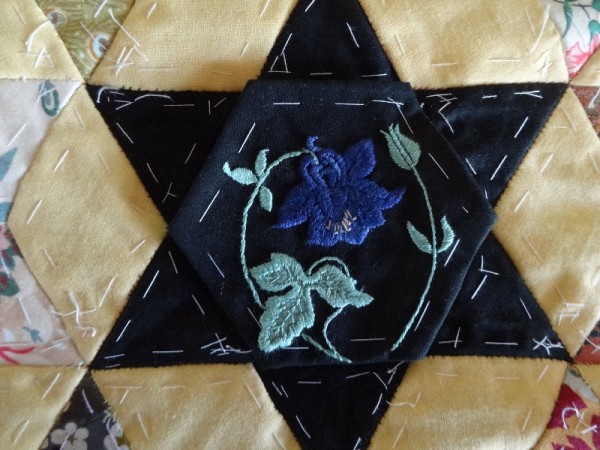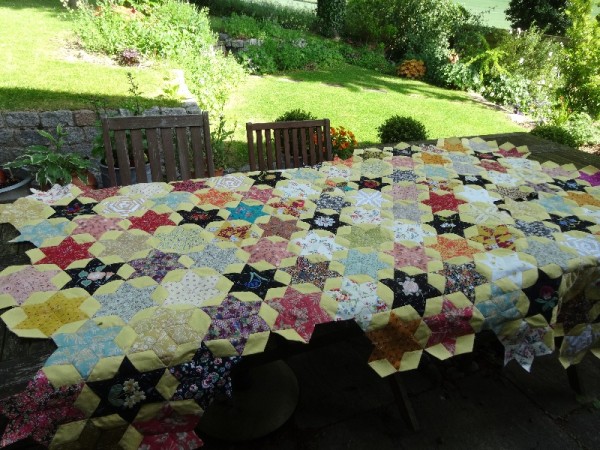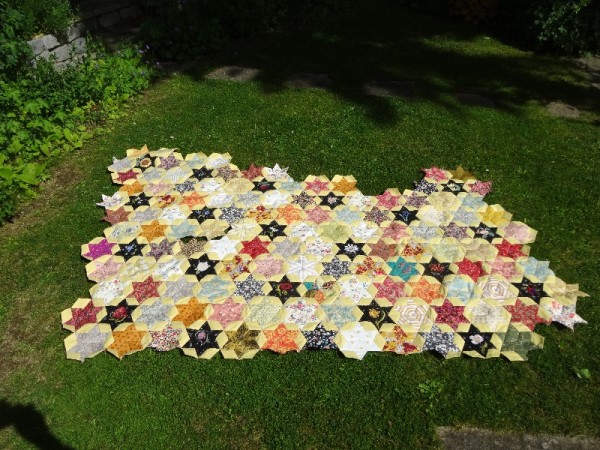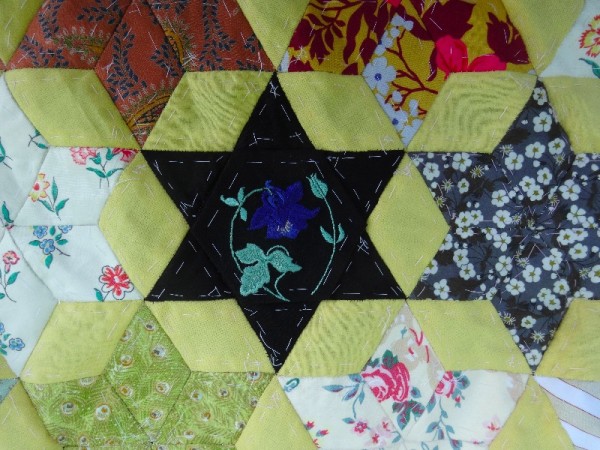This week saw a real push on the altar frontal. We had lots of stars, a clutch of stars with embroidery and a tin full of yellow linking pieces – now they just needed joining up.
I used to think this was an easy job but working with people who’ve not done much of pieced patchwork on papers, I now realise it’s not so simple. The acute angled points of the diamonds are so tiny that it’s very fiddly to fold the fabric in neatly enough to alter neither the angle nor the length of the side. Inaccuracy here has a knock on effect and it’s disheartening – but not unusual – to discover that the 2 sides to be joined up differ by a quarter of an inch or more. This is fine if you’ve done something similar before as you know it just calls for a bit of firm pinning in on the one hand and some gentle stretching on the other. But such details were not uppermost in my mind when working out a design for a group project – squares, or hexagons with angles of 90 and 120 degrees would have been so much easier! It’s quite a learning curve for me too.
I think the quilt is now about two thirds complete and for our next meeting I shall cut out more of the yellow linking diamonds for people to tack up.
This week I also embroidered an aquilegia for the altar frontal quilt. The aquilegias I like best are the everyday variety that pops up all over the place – Aquilegia vulgaris – specially those inky indigo ones, pleated, gathered and scalloped in origami perfection. Look at one fallen petal, and you see it’s a perfect little ice cream cornet, or even better one of those cornucopias baroque artists couldn’t resist turning their hands to. Then turn it the other way up and it’s a small dinosaur. For early plant classifiers the petal was an eagle (Latin ‘aquila’) or a dove (columba) and so we call them aquilegia or columbine instead perhaps of cornetia or dinosauria (and the spell checker isn’t very keen on them either).





16 Comments
I love Granny’s Bonnets (Aquilegias) we have them all over the garden; when we first moved here I stupidly thought I could choose where they would grow, but they stubbornly refused, as usual nature knows best and now I leave them to come up where they will.
I have seen your lovely photographs of them on your blog and I agree they are a delight – and completely beyond human control.
Yes, I can imagine that this may have turned out to be not the easiest of projects for inexperienced contributors, but I think it will look lovely when it’s finished, and they will be so proud of themselves!
Thank you for your encouragement and kind remarks, Rachel.
What a beautiful, variegated assortment of starry imagery, Mary, and many congratulations on the whole design as well as your long, patient and careful stewardship of quilters whose level of proficiency you gently infer may sometimes be in unequal proportion to their enthusiasm. This describes me in a nutshell, sadly. But if I were lucky enough to be seated in a pew near enough to this draped altarpiece, any carefully drafted sermonising would be completely lost on me, I’m afraid, as my concentration would be distracted by needing to admire these little embroidered masterpieces from afar. Tiny glitches to corners or points would hardly be noticed and, honestly, – like cobwebs – I really wouldn’t be looking for them.
Kind words Penny help projects like this along – thank you for such a lovely comment.
What a treat that will be for visitors to your church.
We hope so!
One of my very favourite of the embroideries so far, beautiful. Love the composition of this one. So looking forward to seeing the final reveal of this project, it looks just wonderful. Diamonds are hard, but it is good to take on a challenge, and I am sure your team will pull it off.
Lovely to have your comment, Jane. It’s good to hear you like it so much – when you’re on top of a project it becomes hard to be objective. Many thanks.
Marvellous to see the altar frontal laid out on the grass and really get a sense of the size and scale. It is going to be spectacular! I hope you are planning a lovely unveiling ceremony when the time comes, and that you will let us all see it in situ! X
It’s so helpful to receive such kind comments – I’m never sure people will be interested in a project in progress. I’m sure we’ll have a bit of a celebration and a grand unveiling – but that will be after the quilting, so it’s some way away yet.
OMG! this looks so wonderful Mary – can’t wait to visit on Sat and see it for real. I have noticed in my June Gardens Illustrated another embroidery blogger – Sophie Simpson /What Delilah Did ???? she also has a book out – Secret Garden Embroidery Inspired by the stars I have just got a new (but bought ages ago) sheep tapestry out, the big ewe looks daunting – give me aquilegias everyday!
Susie x
Very kind of you to comment, Susie, especially as you are the prime mover and inspiration behind the project. Thank you.
I know Sophie Simpson’s blog ‘What Delilah Did’ – she started out doing black and white cross stitch silhouettes (various animals, trees, a crown, a key, etc). This is her third book which I haven’t yet seen.
Best of luck with the ewe – not that there aren’t plenty outside your window to urge you on
Those stars will fairly twinkle with joy on the Altar… worth all your hard work and encouragement.
I do love Aquilegias – or Dinosauria if you will – I have rather hopefully scattered some seeds in my raised flower bed just a couple of weeks ago – it is winter here which means it is not really cold but certainly not hot and I do love winter.
I love June in England and though no sign of flaming yet, it has begun pleasantly enough here in Oxfordshire such that I can work with the windows open – and sometimes even sit and sew outside. You can probably still do this in winter in Australia. I’m sure your Aquilegias will come through – they seed themselves like mad here.